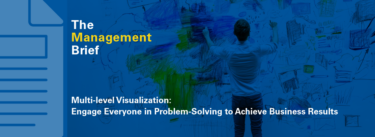I am constantly asked about the best way to implement kaizen. People are eager to learn the details of everything ranging from the ideal staffing size to which metrics should be used, and much, much more.
But before drilling down into these details, let me start with a simple lesson I’ve learned: no company can implement Lean without some prior understanding of what Lean actually entails. Unless you have some lean knowledge before you launch any kaizen, your traditional (“batch” rather than “flow”) thinking will overwhelm you at every turn. Without the knowledge of what is possible you simply won’t get very far.
I’ve found that this lean knowledge has to be imported. Nothing beats actual experience and the wisdom of a sensei who has done this work. That is why I recommend the use of a good lean consultant AND a strong Kaizen Promotion Office (KPO) inside the company working together.
When I first got started with Lean 30 years ago, there were few external resources to go to. We had to build the KPO from the inside and train people as we went along. That’s no longer the case today. You have the option of hiring good lean talent from the outside as well. Either method will work; just make sure that the KPO leader is a highly talented individual who can be groomed for future advancement in the company, perhaps even your eventual replacement as CEO.
The kaizen office is a key resource for you and should be staffed by high potential future leaders in your company. It is a great training ground for your best and brightest. The outside consultant should introduce the lean knowledge, push everyone forward, train the KPO, and assign a lot of homework to complete before the next visit. The KPO needs to organize the kaizens, do the follow up work to make sure everything is implemented, and be the internal lean trainer when the outside consultant is not there.
Staffing and length of a kaizen can vary depending on what you are working on. There is no hard and fast rule. Just remember that kaizen is a “doing” exercise and not a “planning” exercise, so you want to leave enough time to actually put a new layout in place. Three days is a minimum time frame, but a full week or longer is better. The key is that the participants should work full time on the kaizen for the entire time. That is what makes kaizen such a powerful tool. The idea that you can’t free up someone for a full week is ridiculous. After all, what do you do when people go on vacation or are out sick? Anyone who has a reason for NOT deploying their people full time on this kaizen is simply making excuses for certain failure.
A team of 8-10 people is a reasonable size for a one-week kaizen. This should include both hourly and salaried people. It should have at least a couple of people who do the work every day and maybe their supervisor. If it is on the shopfloor someone from maintenance and the tool room should participate so that if something needs to be built or altered you can do it instantly. Have the KPO and the manager of the area gather all information possible about the current state before the kaizen in order to not waste time during the kaizen and to be able to set a clear objective of what can be accomplished during the week. On the Friday afternoon before the kaizen bring all the participants in for training on key lean concepts and terminology, and share the paperwork you will use during the event (we used the paperwork that we were given by several of Taichi Ohno’s disciples). Be sure to communicate what the daily expectations are.
I recommend that you have a leaders meeting every afternoon during the event where the leaders present to the consultant, the KPO, and management what they achieved today and what their plans and goals are for tomorrow. At Wiremold, I found that attending these daily leaders meetings kept me abreast of what was going on and allowed me to have input and communicate crucial information. I tried to attend every one of these sessions. As for shutting down production during these kaizens, I’ve found as a general rule that we don’t shut down as we still have to keep up with our customers! At the same time we know how disruptive kaizen events can be, so we always try to build a little inventory in advance so that our customers don’t have to suffer as we work to get better.
Because kaizen is a “doing” exercise you need to take action right away. For example, if you are creating a new flow cell, equipment should be moving by late morning or early afternoon of the first day. If you are doing a setup reduction kaizen, you should plan to do at least two setups the first day, and as many as you can the rest of the week (allowing for the alterations that will need to be done to the machines and tools.) If it is an office kaizen, you should plan to complete your value stream map by noon on the first day so you can begin time observations in the afternoon.
If you set stretch goals, there is a lot to accomplish and not much time to do it. A fast start is essential.





